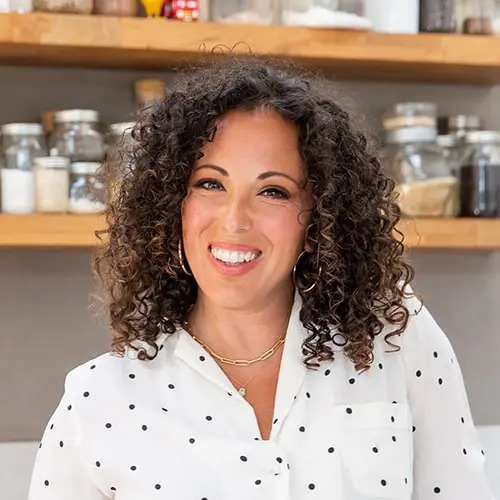I’ve been really lucky to enjoy every moment of my pregnancy so far. I feel good. I’ll even say I’m “glowing”! I’m so excited to become a mom and really enjoying the journey.
But my pregnancy joy hit a bump in the road after my 26-week appointment.
If you’re a mama-to-be or already have kiddos, you know what happens at the 26-week appointment: testing for gestational diabetes.
My OB and I decided that instead of traditional testing (more on that later) I could test my blood sugar at home.
I’ve never had fasting glucose above 90, so gestational diabetes wasn’t even on my radar. I was stunned when my fasting glucose was 114!
After testing my blood sugar a couple more times, I called my OB. She confirmed what I already knew: I met the clinical requirements for a gestational diabetes diagnosis!
So much for “glowing”…
But, I believe EVERYTHING happens for a reason…
Why I’m Grateful I Have Gestational Diabetes
I know it sounds a little out there… but at then end of the day I’m actually grateful for this diagnosis.
I hope I can remove some of the stigma around gestational diabetes.
A GD diagnosis doesn’t mean you’re doing anything wrong. You can still have a happy, healthy pregnancy.
But I also think it’s high time we take a hard look at the usual suggestions for moms with GD. As I’ll share in this post, what most doctors recommend isn’t the only option.
I’m going to share:
- What gestational diabetes is
- Testing for GD (and the alternative to traditional testing)
- Who gets gestational diabetes and why (you’ll be surprised by this one)
- What you can do to manage it (and exactly what I’m doing)
What Is Gestational Diabetes?
Gestational diabetes is basically just high blood sugar that develops (or is first noticed) during pregnancy.
Even women who have 100% normal blood glucose readings before pregnancy can develop gestational diabetes.
Why?
During pregnancy, the placenta, which connects your baby to your blood supply for nutrients and clearing waste, produces high levels of various other hormones. Almost all of these hormones impair the action of insulin in your cells, raising your blood sugar.
Modest elevation of blood sugar after meals is normal during pregnancy. The bigger your baby grows, the more of these insulin-blocking hormones your placenta produces – which is why gestational diabetes is more likely to present in 2nd and 3rd trimester.
Gestational diabetes is diagnosed when fasting glucose is above 100 – but it’s ideal to have it stay at 90 or below. Post-prandial (after meals) glucose above 130 at any time also suggests GD.
Sometime gestational diabetes is called “carbohydrate intolerance” because it’s high levels of carbohydrates that trigger the high blood sugar.
Why Gestational Diabetes Is A Problem
While slightly elevated blood sugar is a normal thing in pregnancy, gestational diabetes is NOT something you should ignore.
If it’s not addressed GD can cause serious issues for mom and baby:
- Baby can grow too large (think 9 pounds and up)
- Increased risk of preterm birth
- Increased risk of respiratory distress syndrome for baby
- Increased risk of preeclampsia for mom (high blood pressure)
- Increased risk of Type 2 Diabetes down the road for mom AND baby
All of these risks can be mitigated if gestational diabetes is discovered and managed – that’s why all women should be screened for gestational diabetes.
Most cases of gestational diabetes can be managed with diet and exercise alone – but some women do need insulin, as well.
How Do I Know If I Have Gestational Diabetes?
EVERY woman should be screened for gestational diabetes. But we don’t all have to be tested the same way.
The most common test for gestational diabetes is called 3-hour glucose tolerance testing. It works like this: you go to the doctor fasting and have your blood sugar tested. Next, you drink a solution that contains 75 grams of fructose. Then, you’ll have your blood sugar tested every hour for 3 hours after.
My main issue with 3-hour glucose tolerance testing (besides drinking that nasty solution) is this: Who actually consumes 75 grams of sugar in one sitting?
I certainly don’t!
Unless you’re guzzling soda or supersized slushies, you’re probably not taking in this much sugar at once, either. It’s the equivalent of 2 large pancakes with syrup – but even if you DID eat the pancakes, you’d have the fat, fiber, and protein in the rest of the meal slowing your absorption of the sugar into your bloodstream.
Because I don’t eat much refined sugar, I didn’t think this type of testing was ideal for me. I asked my OB if I could test my own blood sugar (fasting and post-meal) at home with my glucometer instead and she agreed.
(Side note: my OB is awesome. Every woman deserves a pregnancy care team they trust. Don’t be afraid to try out a couple different doctors until you find a team that listens, makes you feel heard and understand, and is responsive to YOUR wants. That doesn’t mean they’ll always say yes to what you want – but they should be willing to consider your requests.)
My Test Results
The next day I ran my fasting glucose…..yikes…106?
Pre-pregnancy, I’d never had fasting blood sugar above 90!
Post-meal, I tested at 127 – then later it rose to 141. I knew that wasn’t good.
The next day, my fasting was 114.
(Remember – GD is diagnosed when fasting glucose is above 100 and post-meal rises above 130).
The results were a shock to me – especially because I’d been following a lower-carb, Paleo/keto style diet. In pregnancy, I’d increased my carbs a little – think a gluten free waffle with almond butter, a teaspoon of honey in my tea, or a slice of gluten free bread once a day.
Pregnancy cravings are real – but it’s not like I was eating pints of ice cream or loaves of bread. How could I have gestational diabetes?
Risk Factors For Gestational Diabetes
Once I took a deep breath, I reminded myself of what I already knew:
Even women with totally normal fasting glucose and good general glucose control can wind up with gestational diabetes in pregnancy.
It wasn’t my diet, but my genetics that put me at increased risk for GD:
#1 I have Polycystic Ovarian Syndrome (PCOS) —this leaves me already more prone to insulin resistance
#2 I have a family history of Type 2 Diabetes – and my mom had gestational diabetes in her pregnancy
#3 I’m non-white. Scientists aren’t sure why, but non-white people have an increased risk of gestational diabetes
Being overweight is also a risk factor for gestational diabetes, but not one that I have personally.
Once I accepted that I had GD, I shifted to action mode: how was I going to manage this so I didn’t need insulin injections?
The Normal Treatment For Gestational Diabetes
The standard recommendations for managing GD is a diet high in complex carbs – about 175 grams per day.
Suggested sources of complex carbs are bananas, whole grains, fruit, rice, and oats.
You’ll also need to monitor your blood sugar 4-7 times per day with a glucometer at home.
Many women are even required to meet with a dietitian to help implement these changes (my insurance required this).
If these diet changes can’t manage your blood sugar, the next step is insulin injections.
As a functional medicine practitioner, these recommendations didn’t jibe with me.
What made more sense to me: a modified keto diet and closely monitoring my blood sugar (plus getting gentle exercise – like walking – every day).
My OB agreed that as long as I could keep my fasting glucose under 100 (preferably under 90) and my post-meal under 120, I could do what worked for me.
An Alternative Way To Manage Gestational Diabetes
A modified keto diet (aka low carb) makes sense for managing gestational diabetes because it is carbohydrates that cause the rise in blood sugar.
Eat less carbs and your blood sugar won’t rise as high. It’s pretty simple (and intuitive).
While I’d like to take credit for the idea of using a modified keto diet to manage gestational diabetes, it was actually Dr. Lois Jovanic. Dr. Jovanic is one the the foremost experts on diabetes in pregnancy and previous director and chief scientific officer of the Sansum Diabetes Research Center.
Here’s what she has to say about the standard recommendations:
“Honestly, 175 g of carbohydrate is stupid! Women should be going as low as it takes to keep their blood sugar regularly under 90 mg/dl (5 mmol/L). Women ask me, ‘Do I have to eat carbohydrates?’ and I say, ‘No you do not!’ If you do eat carbohydrates [with GD], you will have to have insulin. It is that simple.”
Nutritional ketosis is actually a natural state for pregnant women: pregnant women have higher circulating blood ketones than non-pregnant women.
So why is the standard recommendation to eat 175 grams of carbs per day?
It’s because of a misguided fear of diabetic ketoacidosis in pregnant women. One sign of diabetic ketoacidosis is high levels of ketones in the urine – but that doesn’t mean that ketosis and ketoacidosis are the same thing.
Some experts even suggest that having circulating ketone is not only normal and safe, but supportive to optimal fetal neurologic and brain development.
What To Eat When You Have Gestational Diabetes
No matter what diet you’re eating, the MOST important thing is to regularly test your blood sugar levels to ensure they stay in the normal ranges. Both too high and too low are dangerous for growing baby – so test regularly.
Testing 4 -7 times a day is a good place to start. Test when you wake up (fasting) and then after each meal. If you blood sugar rises too high after a meal, that’s a sign you ate too many carbohydrates at that meal.
Secondly, it’s important to eat adequate calories and to not go long periods of time between meals. If you’re not eating enough or going too long between meals, you’re more likely to have problems managing your glucose levels.
Dr. Jovanic also recommend avoiding what she calls “naked carbs” or eating carbohydrate-rich foods all by themselves. Instead, pair carbs with fat and protein to slow absorption. (I.e. a handful of crackers by itself vs. crackers with nut butter).
Getting exercise every day also helps manage blood sugar levels.
What I’m Eating Now
Here’s a peek into what a day of eating looks like for me:
Breakfast: 2 eggs with a sprinkle of shredded pasture raised cheese, cooked in pasture raised butter. Topped with a small avocado and a handful of sliced cherry tomatoes. Rasa herbal Koffee with a splash of grass-fed whole cream and a scoop of collagen.
Lunch: steamed veggies (broccoli, cauliflower, zucchini) with tahini sauce and poached salmon.
Snack: chicken liver pate on celery sticks
Dinner: Homemade Tom Kha soup with veggies, chicken, coconut milk, lime juice, coconut aminos, fish sauce, and green curry paste –yum!!
One last important change I made: adding in late night protein, right before bed.
When I first switched to low carb meals, my post-meal glucose dropped right into line. But my fasting glucose in the morning was still too high. Why? It was because of something called the “Dawn Phenomenon.”
The Dawn Phenomenon occurs when your fast overnight (for me, it was 12+ hours between my dinner and breakfast). The extended fast would kick my body into gluconeogenesis, causing my morning fasting glucose to spike (usually between 99 and 106).
Increasing my evening protein (instead of half a chicken breast, I’d eat a whole one) and adding a tablespoon of psyllium husk to help slow glycemic uptake both did the trick: as soon as I made those changes, my fasting glucose dropped below 90 and stayed there.
My Gestational Diabetes Journey (And My Goal In Sharing This)
For now, eating a modified keto diet, exercising, and testing my glucose levels 4-7x times a day is working to manage my gestational diabetes.
My OB and I are both verrrry happy with my results and that I don’t need to use insulin shots. (And I’m sure baby boy is too!)
As my pregnancy progresses, I might need to switch things up: adding a bit more carbs in or dropping my levels down. Regular glucose testing will help me know what to do.
My goal in sharing this information is to help remove the stigma around gestational diabetes and bring light to an alternative way of managing GD that might work better for you.
But keep baby’s safety first in mind: if you have GD, you should talk with your doctor before making any changes to your treatment plan.
Have a doc who’s unwilling to even consider an alternative to the standard recommendations? It might be time to find a doctor who is willing to work with you.
Hang in there, mama! I know how scary a gestational diabetes diagnosis can be – but I also know you can manage it and keep on glowing.
If this resonates with you, I’d be honored to have you book a 20-minute consult with my team. These consults are totally free and a chance for us to share how we are trained to help you!
→ Learn more and book a free consult with my team here.
At the Reverse-Age Method, we believe in a holistic approach to perimenopause and beyond, that addresses the root causes of your symptoms (like insomnia, hot flashes, night sweats, erratic periods, fatigue, skin aging, weight gain, and brain fog)– to also slow the pace that your cells are aging. Whether it’s improving gut health, optimizing detox function, enhancing mitochondrial function, or building muscle mass, our comprehensive program has got you covered.
If you’re new here, be sure to check out our Blog Page for more insights and tips on how to thrive during perimenopause. Our blog is packed with practical advice, success stories, and the latest research to help you on your journey.
For more updates and community support, follow us on social media:
You May Also Like...
Are Worms The Next Frontier of Health? Everything You Need to Know About Helminth Therapy
I talk a LOT about clearing infections and overgrowths - Small Intestine Bacterial Overgrowth (SIBO), yeast overgrowth…
Why Your Gut Health and Microbiome Make-or-Break Your Hormone Balance
Acne worse than puberty, ten pounds that won’t budge, a period-induced mood swing that turns you into a totally…
Whether you’re looking for help with your gut, your hormones, or both, our team of practitioners work together to treat the WHOLE you – guiding you to a healthier mind, body, and spirit day by day.



